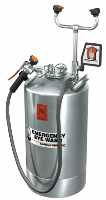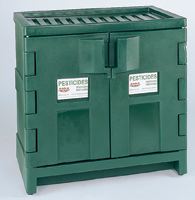 |
 |
| MSDS Topics |
Free Sites | FAQ's | Regulations | Glossary | Software | Suppliers |
| Books | Forum | Poll | Fun stuff | Quiz | Store | |
| MSDS and safety supplies | Search ALL our MSDS info | |||||
 | |||
 |
 |
 |
|
| Title: 05/07/1993 - MSDS requirements. | |
| Record Type: Interpretation | Standard Number: 1910.1200 |
May 7, 1993
Mr. Jere D. Kimmel
Regulatory Management Associates, Inc.
9207 Outlook Drive
Overland Park, Kansas 66207
Dear Mr. Kimmel:
This is in response to your inquiry of April 14, concerning the Occupational Safety and Health Administration's (OSHA) Hazard Communication Standard (HCS), 29 CFR 1910.1200.
Your first concern addresses the Superfund Amendments and Reauthorization Act (SARA) Title III reporting requirements, which is under the Environmental Protection Agency's (EPA) jurisdiction and can be better addressed by the EPA. You may write to your Regional EPA Office at:
|
or call the EPA RCRA/Superfund/UST hotline at the following number: 1-800-424-9346. Your second question addresses the suitability of a generic material safety data sheet (MSDS). As you are probably aware, the requirements for MSDSs are found in paragraph (g) of 29 CFR 1910.1200. MSDSs must be developed for hazardous chemicals used in the workplace, and must list the hazardous chemicals that are found in a product in quantities of 1% or greater, or 0.1% or greater if the chemical is a carcinogen. The MSDS does not have to list the amount that the hazardous chemical occurs in the product. Therefore, a single MSDS can be developed for the various combinations of K, P and N in your fertilizer, as long as the hazards of the various fertilizer mixtures are the same. This "generic" MSDS must meet all of the minimum requirements found in 29 CFR 1910.1200(g), including the name, address and telephone number of the responsible party preparing or distributing the MSDS who can provide additional information. We hope this information is helpful. If you have any further questions please contact the Office of Health Compliance Assistance at (202) 219-8036.
|
 Working at a remote location? Portable eye wash units from Safety Emporium can help meet OSHA requirements. |
Sincerely,
Roger A. Clark, Director
Directorate of Compliance Programs
April 14, 1993
Roger A. Clark
Director of Compliance Programs
US Dept. of Labor - OSHA
RM #3461
200 Constitution Ave. N.W.
Washington, D.C. 20210
Re: OSHA Instruction CPL-2-38C Oct.22, 1990 Office of Health Compliance Assistance Page A-31 (9)(4)
Dear Mr. Clark:
 Good labeling and signage are critical in preventing accidental poisoning. Get your signs and labels at Safety Emporium. |
I am writing you at the suggestion of Glen Taylor of the Kansas City Regional OSHA office. My business, Regulatory Management Associates, Inc., provides consultation, SARA Title III reporting, MSDS Data Bank and training services involving OSHA/ Employee Right-To-Know Laws and EPA/Community Right-To-Know Laws to the Golf Course and Lawn Care industry including the Turf Chemical Distributors that supply them. The purpose of this letter is to have a clarification of the MSDS policy toward the class of chemicals that make up fertilizer; N-Nitrogen P-Phosphorus K-Potassium (NPK). Presently, at least 80% or more of the manufacturers are providing an MSDS for each combination. This is a monumental task when you consider each ingredient usually will range from 0 to 40 in content. Depending on the weather and region of the country an average Golf/Lawn facility may have up to 20 different combinations. Multiply that by individual preferences of the managers of each of these facilities and you have almost endless possibilities.
|
According to the SARA Title III reporting the general TPQ of chemicals not specifically listed is 10,000 lbs. or more. This, I understand, we report by the MSDS assigned to the combination. For example: 5-10-5 - 4,000 lbs., 10-10-10 - 5,000 lbs., 0-0-40 - 6,000 lbs., 30-0-0 - 5,000 lbs., 30-20-10 - 7,000 lbs., 10-15- 20 - 8,000 lbs., 20-10-5 - 3,000 lbs., 40-0-0 - 9,000 lbs., - Total lbs. equals 47,000 lbs. There is no reportable 311 or 312 quantity since the report is based on the individual chemical as defined by the MSDS.
As you can visualize the quantity could be over 100,000 lbs. if you add the NPK combinations with pesticides that are used. I might add that most fertilizer storage areas are located near streams, lakes or storm sewers. The community and its first responders have a "Right-To-Know" so that proper planning can take place.
|
In addition, because of the countless combinations possible, the manufacturers have a logistical problem in supplying the required MSDS's. The problem exists at the facility of having the correct MSDS of each NPK combination. We can resolve the problem by instructing the manufacturer to produce a generic MSDS for all NPK combinations with maybe the exception of Ammonium Nitrate and Potassium Nitrate. Without complicating matters, I would also suggest that the NPK in pesticide combinations be recognized in the same manner. To Summarize:
|  Get pesticide and flammable storage cabinets at Safety Emporium. |
Mr. Clark, I believe this situation because of its scope and potential problems needs immediate attention. Please let me know your thoughts.
Sincerely yours,
Jere D. Kimmel
President
The official, public domain, OSHA version of this document is available at http://www.osha.gov/pls/oshaweb/owadisp.show_document?p_table=INTERPRETATIONS&p_id=21117&p_text_version=FALSE